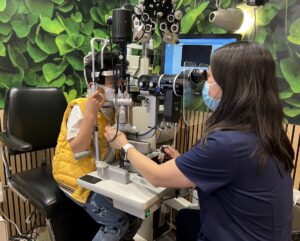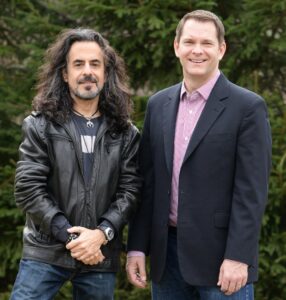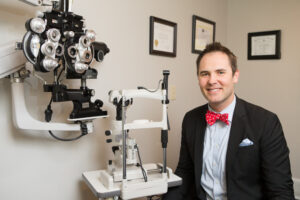sponsored content
June 1, 2023

Since working with Treehouse Eyes, Dr. Chan has been able to better connect with patients and their parents on myopia care.
Myopia management is one of the hottest topics in optometry and getting attention within ophthalmology as well. Yet, with all the buzz around the subject, industry sources say only about 3% of myopic kids in the U.S. are being treated. To learn why that number is still so low, Review of Myopia Management went to the pioneers in myopia management, a company that literally put full scope myopia management all over the map (now with about 70 locations in 25 states), to learn what they’re doing that other doctors aren’t.
In this interview, the two co-founding partners of Treehouse Eyes, Dr. Gary Gerber and Matt Oerding, explained how the country’s largest provider of this important service is helping establish full scope myopia management throughout the country, along with two Treehouse Eyes partners, Dr. David Kading and Dr. Selena Chan.
John Sailer, Review of Myopia Management: Matt, you’re now nearly seven years into what you internally call, “Your battle on myopia.” What have been your biggest successes, failures, and learnings?
Matt Oerding, Treehouse Eyes: Thanks, John. Without question the biggest success is that we have treated thousands of kids with excellent clinical results. We all know the stats on how big of a problem this is, and we developed Treehouse Eyes so doctors can rapidly partner with us to allow them to treat even more kids. The disease is growing exponentially, and we have put together a scalable program for doctors — clinical through practice management — to allow doctors to scale with us to make sure they keep treating even more kids. Our vision has been to build the most trusted brand in myopia care, and I’m thrilled that we have done that.
RMM/Sailer: Gary, I’ll let you talk about some of the failures and learnings.
Gary Gerber/Treehouse Eyes: Sure, give Matt the easy question! I’m the first one to admit that we made our fair share of mistakes. Everything from originally “winging it” to now using a proven clinical protocol, scheduling paradigms, fee presentations to parents, and the messaging in our marketing. We like to joke internally that the good news in us making all those mistakes that we see others making all the time is that doctors who work with us won’t repeat them!
RMM/Sailer: Can you give me an example of one “mistake” that stands out?
Treehouse Eyes/Dr. Gerber: Before we opened, we did a lot of parent research. That allowed us to customize our marketing messaging since different parent personalities respond to different messages. One thing I personally didn’t account for was that those same parents should be handled and addressed differently while they’re in the practice. Now, we train docs on exactly how to do that. The differences are significant.
RMM/Sailer: Dr. Chan, given what Dr. Gerber said above, how have the results of your case presentation changed since working with Treehouse Eyes?
Selena Chan, OD: During the initial training, doctors are shown the fascinating parent/consumer research that defines discrete parent personality profiles. While all parents want the best for their kids, their own internal drivers that ultimately get them to move forward with treatment can be very different. Treehouse Eyes Academy taught myself and my staff how to recognize these different parent types and how to address them. As a result, it’s now a rarity that parents don’t start a recommended treatment. We are treating many more kids now than before we started working with Treehouse Eyes.
RMM/Sailer: How did you come up with your implementation model?
Treehouse Eyes/Oerding: Initially, there was a lot of learning through trial and error in our first operated centers. Gary spent weeks at a time in the centers leveraging his years of practice management experience. He would video case presentations, watch interactions with parents, track close rates, etc. We probably went through 10-15 iterations of our case presentation alone in the first 18 months to optimize it.
Then, once we started our franchise model, we had to refine all that we learned to make sure it also worked in primary care practices. Since we had the foundation figured out in our flagship centers, that part went a lot faster.

Gary Gerber and Matt Oerding have been working together to help myopic children for the last seven years.
Treehouse Eyes/Dr. Gerber: To that point, as we launch new services, such as Treehouse AMP (our new automated marketing platform), we continue to test and learn in our company centers before we do a controlled launch across the country. Our breakthrough telehealth consultation program is another example of this. We started it in our two operated centers, and it’s now being tested in 10 franchise locations across the country to get it fine tuned. This program allows parents to get educated with one of our resources before ever visiting a clinic, reducing chair time, and increasing close rate.
RMM/Sailer: What are the top seven things a practice owner must do to start myopia management and sustain it?
Treehouse Eyes/Oerding: Well first, they must go all in. Frankly, if they get excited after a webinar and put it on their ever-growing to-do list, it won’t get done. Dabbling doesn’t work for myopia management, or any other specialty. It is better to refer to another practice than dabble.
Second, they must have the clinical desire to really, deep down in their optometric soul, recognize myopia as more than a benign optical inconvenience. If they don’t, they’ll fail as they won’t have the confidence to recommend treatment and charge appropriately.
Third, they need to have the clinical acumen and commit to spending time staying up to date on the onslaught of information that continues to come out. Luckily for our doctors, our world class clinical advisory board helps us sort the wheat from the chaff, so our doctors stay up to the second on the myopia management science.
Technology is the fourth area. They must have the right tools to do this the right way. Two staples are a great topographer and optical biometer.
Fifth is they have to be willing to let us train their staff for them. We onboard all new practices with Treehouse Eyes Academy, a seven-hour program that staff members must complete for them to become Treehouse Eyes certified. It is a mix of synchronous and asynchronous learning that we continue to update and optimize.
Sixth, just as there is solid science to the clinical treatment side of this, there are proven techniques and strategies on the process and management side that encompasses the patient journey, case presentation, fees, documentation, etc. Strong implementation is critical to success.
Finally, number seven, marketing isn’t guessing. Direct-to-parent marketing isn’t easy and, done incorrectly, is very costly. Doctors must purposefully budget, plan, and execute a cogent marketing plan. This is nearly always beyond the scope of doctors. That’s not meant as an insult by any means. Rather, it’s not something they were trained to do. Fortunately, our doctors have our brand power and marketing know-how behind them to do this.
RMM/Sailer: Dr. Kading, you are already a well-known myopia management expert and were already doing a lot of myopia management before working with Treehouse Eyes. Which of the above comments by Matt was instrumental in getting you to join them?

Dr. Kading started working with Treehouse Eyes to ensure he was doing everything possible to treat myopia.
Dave Kading, OD, FAAO, FCLSA: It’s hard to pick just one of Matt’s seven items. From a more macro view, I saw what they were doing around the country and knew that even though our practices were doing well with myopia management, we could be doing even better. Treehouse Eyes has invested heavily on clinical and consumer research, and it made perfect sense for us to tap into that wealth of knowledge.
After only a few months, we’re already seeing things pay off with a more streamlined system, better staff alignment, and more kids in treatment. It was definitely the right decision for us to work with them, and all of the above seven comments ring true for me. In fact, I just did a podcast talking about why I joined Treehouse Eyes, so listen and learn more.
RMM/Sailer: I’ve read a lot about the Treehouse Vision System 2.0 clinical protocol. What is it, and how did it come to be?
Treehouse Eyes/Dr. Gerber: TVS 2.0 is the crown jewel in our clinical armamentarium. We recently published our CAMP Study, one of the largest of its kind. That study took place in a real world, non-laboratory/academic setting, which is very unusual for that large of a study. Based on the results of that study, which was over five years in the making, we were able to distill down the findings to a one-page, easy-to-use clinical protocol that essentially tells our doctors, “If a kid comes in with these X findings, use Y to treat them. If Y doesn’t work, switch to Z.” The doctors love it since they finally are able to treat kids based on great clinical data vs. “I use X a lot because I’m comfortable using it.”
RMM/Sailer: Why do you only work with independent practices?
Treehouse Eyes/Oerding: It’s important for us to work directly with the decision makers in a practice. That doesn’t mean we wouldn’t work with a non-independent if they also can make important practice direction decisions, including driving staff training, KPIs, marketing, and branding decisions.
Treehouse Eyes/Dr. Gerber: One important benefit of working with independent doctors is that they readily understand the practice-building benefits of adding Treehouse Eyes to their practices. They already know that really differentiating themselves in their communities puts them on the fast track to practice growth.
RMM/Sailer: What are future plans for marketing/demand creation?
Treehouse Eyes/Oerding: We are already on our way to becoming THE most trusted brand in myopia care for kids. When parents think of myopia management, they should think of our doctors as the best place to get world-class treatment and experience in treatment of myopia. Over the last 18 months we’ve been increasing our targeted direct-to-parent marketing spend. We continue to optimize it with a focus primarily on PPC (pay per click) and paid social, along with some earned media. We are getting ready to launch our largest spend ever starting in July through the critical back-to-school period across the U.S. to drive more awareness with parents and get them into their nearest Treehouse Eyes provider.
RMM/Sailer: What is the ideal practice to be a franchisee?
Treehouse Eyes/Dr. Gerber: As Matt mentioned above, they have to really want to fight the myopia battle and genuinely care about the problem. Additionally, they must be willing to let us train them and their staff on the particulars of executing our program. Now that we’ve replicated this in so many practices, we know that it’s not particularly onerous to add this to a practice. Initially, it’s just a few additional hours per week. After that and after our team shows up for a practice on-site certification, the program will be in place and docs should be ready to check in with our practice development team once a month for about 30 minutes. Those calls allow us to keep practices up to date since we are continually releasing new services. I’d also add that the majority of docs we work with already do some myopia management, and they were smart enough to realize that they can’t grow it as big or as fast as they’d like without our help.













